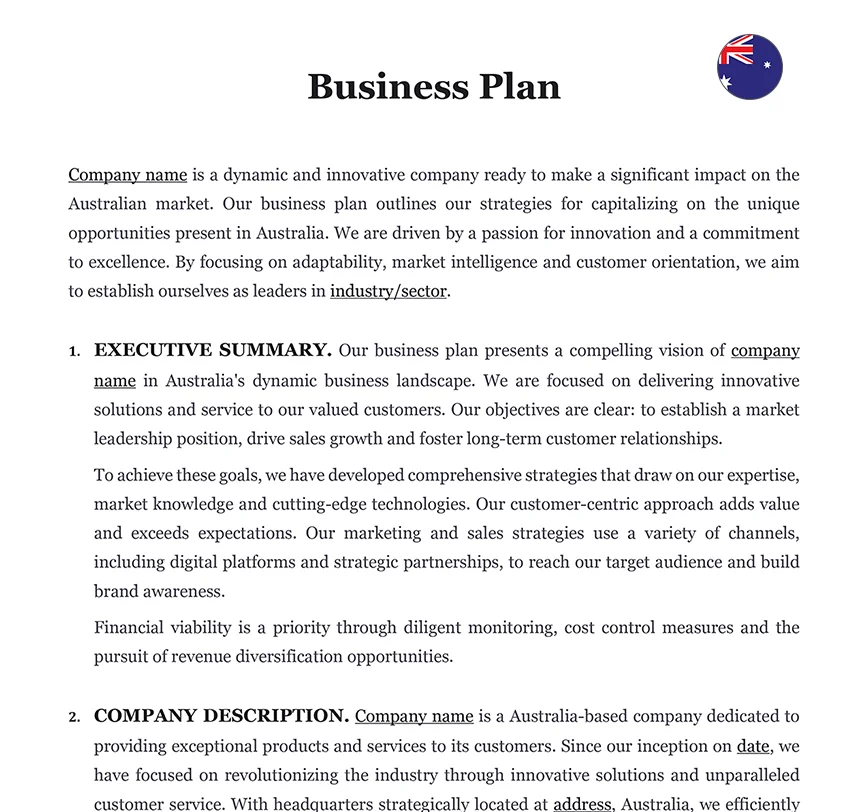The Importance of a Comprehensive Business Strategy
When it comes to starting or expanding a business in Australia, a well-structured business strategy is indispensable. A business plan not only outlines your company’s vision but also details the steps you need to take to achieve your goals. It serves as a roadmap, guiding your business decisions and helping you stay focused on your objectives. Whether you’re seeking investment, planning for growth, or simply trying to establish a strong foundation, a business plan is your go-to document.
Drafting a detailed business strategy is crucial because it allows you to analyze the viability of your business idea, set realistic goals, and map out the strategies you’ll need to reach them. This document covers everything from market research to financial projections, ensuring that you’re well-prepared to navigate the challenges ahead. For those looking to protect their business strategies and intellectual property, our article on Using NDAs to Safeguard Business Secrets in Australia offers valuable insights into securing your company’s sensitive information.
Key Components of a Business Strategy
A business strategy is composed of several key sections that work together to provide a comprehensive overview of your business.
1. Executive Summary: This section provides a snapshot of your business, including your mission statement, product or service offering, and basic financial information. It should be concise yet compelling, giving readers a quick understanding of your business’s purpose and potential.
2. Market Analysis: Conducting thorough market research is essential for understanding your industry, target market, and competitors. This section should include data on market trends, customer demographics, and competitive analysis.
3. Marketing and Sales Strategy: Outline how you plan to attract and retain customers. This could include your marketing channels, sales tactics, pricing strategy, and customer service approach.
For more on structuring your business’s operations and agreements, our article on Legal Steps for Subletting Your Apartment provides insights into forming contracts that align with your business plan’s goals.
Setting Realistic and Measurable Goals
A key element of any business strategy is setting realistic and measurable goals that align with your company’s vision and mission.
1. Short-Term Goals: Identify specific, short-term objectives that you aim to achieve within the first year of operations. These could include securing funding, launching a new product, or achieving a certain level of sales.
2. Long-Term Goals: Establish long-term goals that focus on the growth and expansion of your business. This might involve entering new markets, increasing market share, or diversifying your product line.
3. Milestones: Break down your goals into smaller milestones that can be tracked and measured over time. This allows you to monitor progress and make adjustments as needed.
For guidance on setting achievable goals, our article on Essential Steps for Forming a Business Partnership can provide useful tips on how to align your business strategy with partnership agreements.
Financial Projections and Budgeting
Financial planning is a critical component of your business strategy. It helps you determine the financial viability of your business and ensures that you have the resources needed to achieve your goals.
1. Revenue Projections: Estimate your expected revenue based on market research, pricing strategy, and sales forecasts. This will give you a clear picture of your potential earnings and help you plan for growth.
2. Expense Budgeting: Outline your expected expenses, including operational costs, marketing expenses, and employee salaries. This will help you manage your cash flow and ensure that you have enough capital to cover your expenses.
3. Profit and Loss Statement: Prepare a profit and loss statement that summarizes your projected income and expenses over a specific period. This will allow you to assess your business’s financial health and make informed decisions.
Analyzing the Competitive Landscape
Understanding your competition is crucial for developing a successful business strategy. A comprehensive business strategy should include a detailed analysis of your competitors and how you plan to differentiate your business.
| ➤ Identifying Competitors: List your direct and indirect competitors, including their strengths and weaknesses. This will help you identify opportunities to position your business more effectively in the market. |
| ➤ Competitive Advantage: Determine what sets your business apart from the competition. This could be a unique product feature, a superior customer service approach, or a more efficient operational process. |
| ➤ Market Positioning: Develop a strategy for positioning your business in the market. This involves identifying your target audience and tailoring your marketing and sales efforts to meet their needs. |











